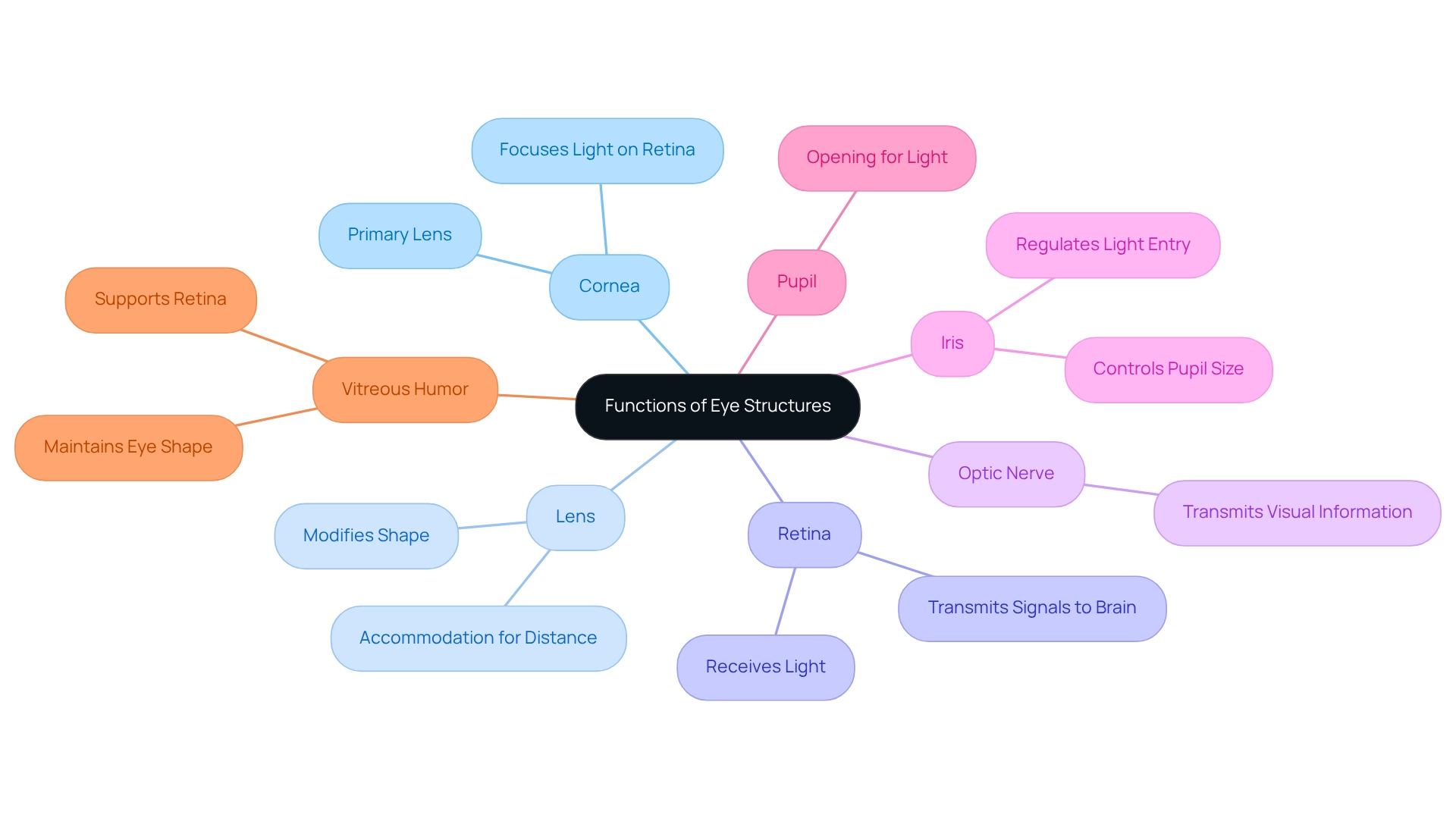Posted by: Northwest Eye in General on May 29, 2025
Overview
Understanding the anatomy of the eye is crucial for effective vision care. We recognize that many may feel concerned about how various structures contribute to sight and how conditions like cataracts and glaucoma can impair vision. A comprehensive knowledge of the eye’s components, such as the cornea, lens, and retina, not only helps in identifying these issues but also enables better diagnosis and treatment of eye conditions. This ultimately leads to improved patient outcomes. We are here to help you through this process, ensuring that you feel supported every step of the way.
Introduction
The human eye is truly a marvel of biological engineering, a complex organ designed to capture the world in exquisite detail. Its intricate anatomy includes essential components such as the cornea, lens, retina, and optic nerve, each playing a pivotal role in the process of vision.
We understand that as the population ages and the prevalence of eye conditions rises, understanding the eye’s structure becomes increasingly crucial for maintaining vision health. From the refractive power of the cornea to the light-sensitive retina, each part contributes to our ability to perceive the environment around us.
This exploration delves into the key elements of eye anatomy, their functions, and the common conditions that can arise. We want to highlight the importance of proactive eye care and informed decision-making for optimal visual health, reassuring you that we are here to help you through this process.
Define the Anatomy of the Eye
The eye’s anatomy is a sophisticated structure vital for sight, comprising several essential components: the cornea, lens, retina, and optic nerve. Each part plays a significant role in the visual process, as the eye functions as a spherical organ that captures light and transforms it into visual information. We understand that grasping the eye’s structure is essential for recognizing how different ailments, such as cataracts, diabetic retinopathy, dry eyes, and astigmatism, can affect sight and overall eye health.
Current statistics show that of the eye is about 23.8 mm, demonstrating a uniform size among individuals, which is crucial for surgical considerations. As our population grows older, the incidence of visual impairment is expected to double by 2050. This emphasizes the need for heightened awareness and preventive measures in eye health, particularly because research highlights the significance of the anatomy of the eye in eye care. A strong understanding of the anatomy of the eye can lead to better patient outcomes.
For instance, understanding how the lens functions can inform treatment options for cataracts, enhancing the effectiveness of surgical interventions. It’s common to feel concerned about conditions like blurred eyesight, which can emerge from irregularities in these structures, indicating the need for corrective measures. Symptoms of blurred sight, if left untreated, can lead to serious health complications. Therefore, it is essential for patients to seek professional help.
Case studies show that patients informed about the anatomy of the eye are more inclined to participate in proactive health measures, ultimately resulting in improved management of their conditions. In summary, the anatomy of the eye is not only essential for sight but also vital for effective eye care. By promoting a deeper comprehension of eye structure, including how issues like unclear sight can arise, we empower patients to make knowledgeable choices regarding their eye health. This paves the way for improved treatment results and overall wellness.
Explore Key Components of the Eye
The eye is a remarkable organ with an intricate anatomy, composed of various essential parts, each playing a significant role in the mechanism of sight:
- Cornea: This clear, dome-shaped layer at the front of the eye bends incoming rays, crucial for focusing images. It not only covers the pupil and the colored iris but also serves as a protective barrier against .
- Lens: A flexible structure that adjusts its shape to focus rays onto the retina, ensuring clarity at various distances.
- Retina: The light-sensitive layer at the back of the eye that converts incoming rays into neural signals transmitted to the brain.
- Optic Nerve: Carries visual information from the retina to the brain, enabling the perception of images.
- Iris: The colored part of the eye that regulates the size of the pupil to control the amount of light that enters.
- Pupil: The adjustable opening in the center of the iris that changes size in response to brightness.
- Vitreous Humor: A gel-like substance that fills the eye, maintaining its shape and allowing rays to pass unobstructed to the retina.
These components work in harmony to create clear sight, with each playing a distinct role in the overall function of the eye. We understand that recognizing their functions is essential for appreciating how they contribute to visual clarity and overall eye health. Recent research underscores the importance of pupil measurements in evaluating neurological function, highlighting the pupil’s role beyond simple illumination control. Furthermore, insights from eye care professionals emphasize the necessity of routine eye check-ups to assess these essential elements, ensuring that the cornea, lens, and retina are preserved for optimal sight. Remember, we are here to help you through this process.
Understand the Functions of Eye Structures
The roles of the anatomy of the eye‘s structures are intricately linked to the process of seeing, and we understand how important this knowledge can be for your peace of mind:
- Cornea: This acts as the eye’s primary lens, bending rays to focus them on the retina, which is essential for clear sight.
- Lens: It modifies its shape to focus rays from objects at different distances, a process known as accommodation.
Understanding the anatomy of the eye is crucial for recognizing how various issues, such as cataracts and glaucoma, can impair sight, as it includes key components like the retina, optic nerve, iris, pupil, and vitreous humor, all of which work together to allow for sharp images whether close or far, vital for daily activities.
For instance, cataracts, which impact more than 24 million Americans aged 40 and above, cloud the lens and obstruct light passage, resulting in unclear vision. We understand that are essential for early identification and management of these issues, ensuring that you can preserve optimal sight throughout your life. Remember, we are here to help you through this process.

Identify Common Eye Conditions and Their Anatomical Links
are intricately linked to the anatomy of the eye, and we understand how concerning these issues can be:
- Cataracts: Cataracts involve lens clouding, leading to blurred vision. This situation frequently necessitates surgical intervention to substitute the lens. It’s reassuring to know that over 90% of patients notice enhanced sight after the procedure, allowing them to regain clarity in their lives.
- Glaucoma: Characterized by damage to the optic nerve, glaucoma is often associated with increased intraocular pressure due to fluid buildup in the eye. It’s common to feel anxious about this condition. Recent studies estimate that around 316,000 individuals aged 85 and older were impacted by non-vision-affecting glaucoma, highlighting its prevalence among the elderly. As Lisa M. Young, OD, FAAO, notes, “This progress brings hope for new and improved treatments, including innovative drug delivery methods, laser therapies, and less invasive surgical options.”
- Macular Degeneration: This ailment mainly affects the retina, especially the macula, leading to the loss of central sight. Understanding the anatomy of the eye is crucial for early detection and management, and we are here to help you navigate this journey.
- Dry Eye Syndrome: Often arising from inadequate tear production or subpar tear quality, this syndrome impacts the cornea and overall eye comfort. If you’re experiencing discomfort, know that you’re not alone; many find relief through various treatments.
- Retinal Detachment: This serious ailment occurs when the retina separates from the underlying tissue, often requiring urgent surgical repair to prevent permanent vision loss. We understand that this can be alarming, but timely intervention can make a significant difference.
Recognizing these conditions and their links to the anatomy of the eye is essential for effective diagnosis and treatment. A thorough understanding of the anatomy of the eye not only assists in identifying these issues but also highlights the importance of timely medical intervention. Remember, we are here to support you every step of the way, ultimately enhancing patient outcomes.
Conclusion
Understanding the intricate anatomy of the eye is fundamental to appreciating vision and maintaining eye health. This exploration highlights the essential components of the eye, including the cornea, lens, retina, and optic nerve, each playing a vital role in the complex process of visual perception. By examining how these structures function and interconnect, we see that a solid grasp of eye anatomy is crucial for recognizing and addressing common eye conditions such as cataracts, glaucoma, and macular degeneration.
We understand that awareness of these conditions emphasizes the importance of proactive eye care. Regular eye examinations and a deeper understanding of eye anatomy can empower you to make informed decisions regarding your eye health. This knowledge not only aids in the early detection and management of various eye issues but also enhances your overall quality of life by preserving vision.
In a time when visual impairment is increasingly prevalent, understanding the anatomy of the eye and its functions is essential. By prioritizing eye health and embracing informed decision-making, you can take significant steps towards maintaining optimal vision and preventing potential complications. Remember, the journey towards better eye health begins with education and awareness, reinforcing the message that caring for your eyes is an investment in your overall well-being.
Frequently Asked Questions
What are the main components of the eye’s anatomy?
The main components of the eye’s anatomy include the cornea, lens, retina, and optic nerve. Each part plays a significant role in the visual process.
Why is understanding the eye’s anatomy important?
Understanding the anatomy of the eye is essential for recognizing how different ailments, such as cataracts, diabetic retinopathy, dry eyes, and astigmatism, can affect sight and overall eye health.
What is the average size of the eye, and why is it significant?
The average sagittal diameter of the eye is about 23.8 mm, which is crucial for surgical considerations and demonstrates a uniform size among individuals.
What is the expected trend in visual impairment as the population ages?
The incidence of visual impairment is expected to double by 2050 as the population grows older, highlighting the need for increased awareness and preventive measures in eye health.
How does knowledge of the eye’s anatomy impact patient outcomes?
A strong understanding of the anatomy of the eye can lead to better patient outcomes by informing treatment options, such as enhancing the effectiveness of surgical interventions for conditions like cataracts.
What symptoms might indicate issues with the eye’s structures?
Symptoms like blurred eyesight can emerge from irregularities in the eye’s structures, indicating the need for corrective measures.
What should patients do if they experience symptoms of blurred sight?
It is essential for patients to seek professional help if they experience symptoms of blurred sight, as untreated issues can lead to serious health complications.
How does patient education about the eye’s anatomy affect health management?
Patients informed about the anatomy of the eye are more inclined to participate in proactive health measures, resulting in improved management of their conditions.
What is the overall significance of the eye’s anatomy in eye care?
The anatomy of the eye is vital for effective eye care, as promoting a deeper understanding of eye structure empowers patients to make knowledgeable choices regarding their eye health, leading to improved treatment results and overall wellness.






